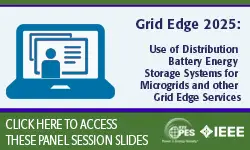IEEE Tutorial Course Applications of Power Electronics to Power Distribution Systems (2005) ? PDF
Arindam Ghosh, Gerard Ledwich
-
Members: FreePES
IEEE Members: $45.00
Non-members: $70.00Pages/Slides: 128
27 Aug 2005
The term power quality is often referred to maintain a near sinusoidal voltage of rated magnitude and stipulated frequency of 50 or 60 Hz at the customer inlet points. However more often than not the quality of power supplied to the customers do not meet these specifications. There are various causes for the degradation of the quality of power that may result in voltage sag/swell, harmonic distortion, voltage flicker etc. But most of these problems can be solved by using power electronic devices. Some of these devices are thyristor based and they are generally used for the high speed protection of power distribution systems. The others are static power converter based and they are used to solve a myriad of power quality problems.
The aim of this tutorial is to introduce the concept of Custom Power which broadly refers to those devices and circuits that are built using power semiconductor switches for the purpose of improving the quality of power. The configurations of different custom power devices, their performance, advantages and limitations are discussed in detail. Some knowledge of power electronics is desirable for an appreciation of the topics covered. However issues such as converter structures, control etc., are not discussed here. We feel that this tutorial will be most beneficial to those graduate students and practicing engineers who are working in the areas of distribution system, harmonics, active filtering, distributed generation etc.
We wish to thank Prof. Peter Sauer of the University of Illinois at Urbana-Champaign and Prof. Elham Makram of Clemson University for making this tutorial possible. Their timely help and suggestions are greatly appreciated. We also wish to thank Prof. M. A. Pai of the University of Illinois at Urbana-Champaign for providing the impetus for the tutorial and Amit Jindal for helping us to correct the manuscript. A preliminary and much shortened version of this tutorial was delivered at the UIUC under the Grainger Lecture Series and we wish to thank Fulbright and Grainger Foundations for this. Finally we thank IEEE Power Engineering Society for giving us this wonderful opportunity ofpresenting the tutorial.
Arindam Ghosh
Gerard Ledwich
The aim of this tutorial is to introduce the concept of Custom Power which broadly refers to those devices and circuits that are built using power semiconductor switches for the purpose of improving the quality of power. The configurations of different custom power devices, their performance, advantages and limitations are discussed in detail. Some knowledge of power electronics is desirable for an appreciation of the topics covered. However issues such as converter structures, control etc., are not discussed here. We feel that this tutorial will be most beneficial to those graduate students and practicing engineers who are working in the areas of distribution system, harmonics, active filtering, distributed generation etc.
We wish to thank Prof. Peter Sauer of the University of Illinois at Urbana-Champaign and Prof. Elham Makram of Clemson University for making this tutorial possible. Their timely help and suggestions are greatly appreciated. We also wish to thank Prof. M. A. Pai of the University of Illinois at Urbana-Champaign for providing the impetus for the tutorial and Amit Jindal for helping us to correct the manuscript. A preliminary and much shortened version of this tutorial was delivered at the UIUC under the Grainger Lecture Series and we wish to thank Fulbright and Grainger Foundations for this. Finally we thank IEEE Power Engineering Society for giving us this wonderful opportunity ofpresenting the tutorial.
Arindam Ghosh
Gerard Ledwich


